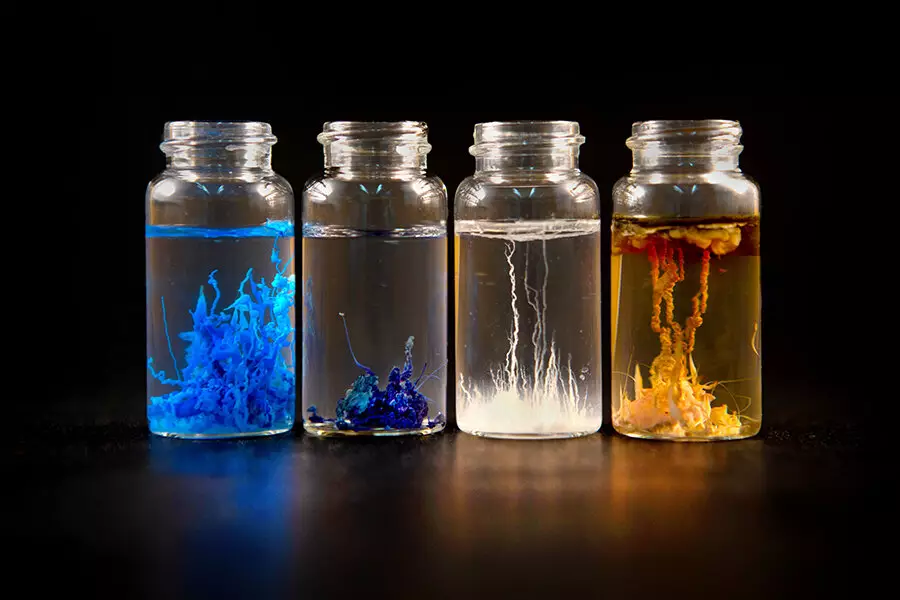Chemical gardens have long been a subject of fascination for chemists around the world. These vibrant and intricate structures, resembling coral formations, have sparked curiosity due to their unique growth patterns and mysterious properties. However, despite centuries of research, the underlying rules and processes governing the formation of chemical gardens have remained elusive. In a recent groundbreaking study published in the Proceedings of the National Academy of Sciences, scientists from Florida State University (FSU) present a new model that sheds light on the growth, shape variations, and transformation of these captivating structures.
Unlike crystals, which grow layer by layer with sharp edges, chemical gardens exhibit a different growth pattern. Oliver Steinbock, a Professor of Chemistry and Biochemistry at FSU, explains that these structures defy the traditional crystal growth model. Additionally, chemical gardens possess the remarkable ability to self-heal when breached, further adding to their allure. These unique properties make chemical gardens a compelling subject for materials research, as they offer insights into the development of materials that can reconfigure and repair themselves.
The Formation and Intricacies of Chemical Gardens
To create chemical gardens, metal salt particles are introduced into a silicate solution. The salt reacts with the solution, giving rise to a semipermeable membrane that grows upward, resembling the appearance of coral. The first recorded observations of chemical gardens date back to 1646, and their intriguing formations have captivated scientists ever since. Beyond their aesthetic appeal, the chemistry behind chemical gardens is also relevant to other phenomena, such as the formation of hydrothermal vents and the corrosion of steel surfaces.
The groundbreaking mathematical model developed by the FSU researchers, including Professor Steinbock, postdoctoral researcher Bruno Batista, and graduate student Amari Morris, draws inspiration from experiments involving the injection of a salt solution into a larger volume of silicate solution between two horizontal plates. Through these experiments, the researchers observed distinct growth modes and a transition from a flexible to a more brittle material as it ages. By simulating various shape patterns, such as flowers, hair, spirals, and worms, within the confined environment between the plates, the scientists were able to elucidate the emergence of these patterns during the chemical garden’s development.
The researchers’ model successfully explains the universal nature of chemical garden formation, despite variations in the chemical composition of salt solutions. It accounts for patterns consisting of loose particles, folded membranes, and self-extending filaments. The model also validates the observation that fresh membranes expand in response to microbreaches, highlighting the remarkable self-healing capabilities of the material. Bruno Batista emphasizes the significance of their findings, stating that the team has successfully captured the essence of what is required to describe the shape and growth of chemical gardens.
Through their comprehensive study, the FSU researchers have made significant strides in unraveling the complexities surrounding the growth, shape variations, and transformation of chemical gardens. Their mathematical model offers valuable insights into the underlying mechanisms and universal principles that govern the formation of these mesmerizing structures. As the scientific community continues to explore the potential applications of chemical gardens, this research paves the way for the development of innovative materials capable of reconfiguration and self-repair.
Chemical gardens, with their captivating patterns and intriguing growth mechanisms, have fascinated chemists for centuries. Thanks to the groundbreaking research conducted by the team at Florida State University, our understanding of these structures has greatly expanded. By developing a new mathematical model, the researchers have uncovered the underlying rules and processes that govern the formation of chemical gardens. This knowledge not only deepens our appreciation for the beauty of these structures but also opens doors to the development of materials with reconfiguration and self-repair capabilities. The future applications of chemical gardens are vast, and further exploration in the field will undoubtedly lead to remarkable breakthroughs in materials science.


Leave a Reply